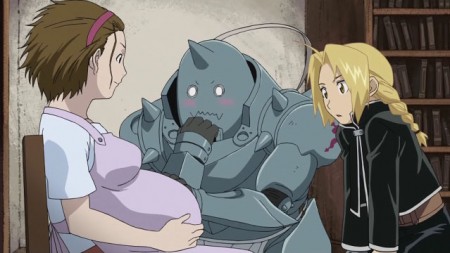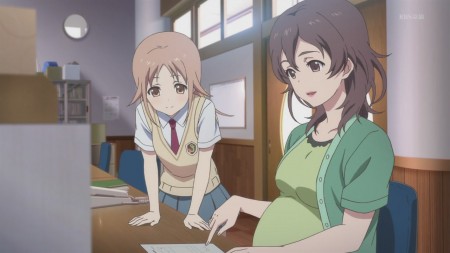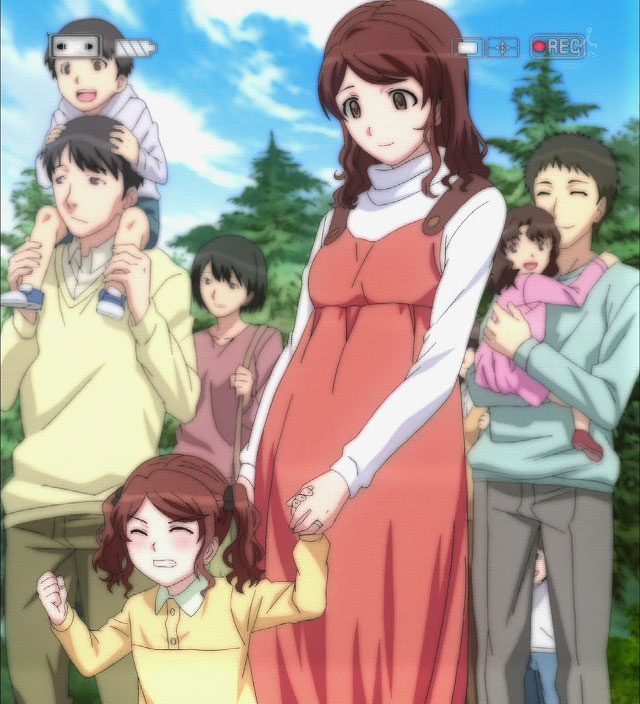Ask John: Why are Pregnant Women So Rare in Anime?

Question:
Why aren’t there more pregnant characters in anime? I was surprised to see a pregnant teacher in the new show Tari Tari. The only other anime I can think of that had a pregnant character was in Kiki’s Delivery Service and Naisho no Tsubomi (plus some hentai titles I can’t recall).
Answer:
Japan’s drastically falling birth rate immediately springs to mind when considering the rarity of pregnant Japanese women. After all, in order to convey a sense of realism and believability to viewers, anime should reflect aspects of the world that are familiar to Japanese viewers. But contemporary birth rates don’t explain the absence of pregnant women characters in older anime. Seemingly oddly, even new mothers in prominent older anime are never depicted visibly pregnant. In Dragon Ball, Bulma, Chi-chi, and Juuhachigou all give birth, yet none of them were ever depicted with large bellies. Likewise, Misae Nohara gives birth to a daughter during the Crayon Shin-chan television series, yet Misae is never shown pregnant.
I have two personal theories to explain why obvious pregnancy is relatively rare in conventional anime and why pregnancy is lopsidedly so much more frequently depicted in adults-only erotic anime than in mainstream anime. Observers should not forget that anime is creative literature. Like all creative fiction, it must consider the impact and nuance of the choices it makes. When female anime characters are depicted obviously pregnant, like Osono in Kiki’s Delivery Service, Tomoko Takahashi in Tari Tari, and Ezra in Vandread, they’re consistently happy, nurturing, maternal characters. They’re also depicted as experienced confidants willing and eager to give advice and listen without being judgmental. The imagery of pregnancy itself evokes the sense of motherhood, of compassion and love, of tenderness. Therefore anime can’t include obviously pregnant women without accounting for the impression these characters will make on viewers. Characters like Bulma, Chi-chi, Juuhachigou, and Misae Nohara are never literally shown pregnant because doing so would enhance and alter the impression of these characters in the minds of viewers. These mothers are stern, disciplinarian, short-tempered. Depicting them in late stage pregnancy with the same short-temper would compromise the matronly beauty of pregnancy. Depicting these women with soft, kind-hearted tenderness would forever compromise their established typical personalities. For example, in Gurren Lagann Kiyoh’s personality changes dramatically after she’s depicted pregnant and gives birth to a daughter. Anime simply has to be cautious about depicting pregnant women because if the anime isn’t going to acknowledge the pregnancy, isn’t going to subtly characterize the pregnancy, then it’s merely a distraction from other, more important themes and characteristics and should be excluded. The visual imagery of pregnancy simply carries so much meaning that it can’t be ignored or overlooked. So if an anime isn’t going to specifically focus attention on a character’s pregnancy itself, it’s better to not include a pregnant character at all. For example, Rose of Versailles includes several pregnancies, yet none of them are ever shown on-screen. Allison to Lillia is a multi-generational show, yet it skips over Allison’s pregnancy.
The relative absence of obvious pregnancy in anime may also be a subtle form of social consideration. Traditionally sex education has not been a prominent aspect of youth Japanese education. Keeping in mind the fact that anime is primarily targeted at children, the imagery of pregnant women may illicit questions from children viewers that parents may not be comfortable answering. So mainstream anime that children might watch may avoid depicting pregnancy as a favor to parents. For example, the magical girl anime Cutey Honey F skips over Honey Kisaragi’s pregnancy. Tsubomi’s mother in Heartcatch Precure gets pregnant but is never shown with a large belly. On the other hand, pregnancy is relatively frequently depicted in adult anime and ero-games like Kisaku Spirit, Elfina, Ane Haramix, Himekishi Janne, Yakin Byouto, and Shin Ringetsu because adult viewers fully understand what pregnancy is and represents. While pregnancy may represent compassion, bringing forth new life, motherhood, and the question of how babies are made for young viewers, for adult viewers pregnancy can represent fertility, femininity, and positive proof of sexual activity. So because pregnancy is such a, excuse the pun, pregnant concept, all literature needs to handle its depiction carefully. Anime must be especially careful about its contentious depiction of pregnancy because of the audience that may be watching the anime, and because of the effect the imagery of pregnancy can have on a story and a viewer’s focus.



